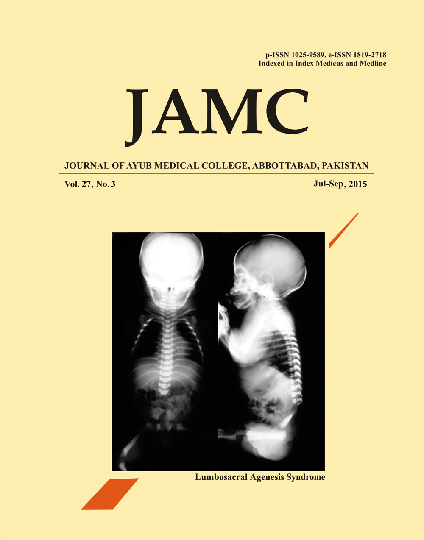SOCIO-DEMOGRAPHIC STUDY OF HEPATITIS C PATIENTS VISITING TERTIARY CARE HOSPITAL
Abstract
Background: Hepatitis C is a very common blood-borne disease of liver caused by Hepatitis C Virus and about two third of these patients will ultimately end up having liver cirrhosis or hepatocellular carcinoma. This study was carried out to determine the sociodemographic status of the hepatitis C infected patients visiting tertiary care hospitals in Lahore, Pakistan. Methods: This study was conducted during the months of October and November 2009. In this cross sectional study, 154 volunteer patients of HCV were included. They were investigatedfor sociodemographic variables and were statistically analysed by SPSS-15. Results: Of these 154 patients, a high percentage of patients were females (70.1%). Majority of the patients belonged to the families of labour occupation (39.4%) of which 71.4 % were illiterate. Gender was found significantly associated with categories of sleep disturbance (p<0.05) and tension (p<0.05) among HCV patients. Married patients were significantly associated with tension (p<0.05) and a significant emotional and behavioural change in their attitude was also found (p<0.05). Patients with shorter interval after first diagnosis of the disease felt more emotional and had greater behavioural changes in their attitude (p<0.05). Conclusion: Incidence of Hepatitis C was higher in females and married females with shorter interval after first diagnosis of the disease were more depressed.References
World Health Report 2004. Regional Health System Observatory-EMRO. Health System Profile, Pakistan 2004; 64.
Ten Years of South Asia Human Development Report (1997-2007). June 27-28 2008; 6-8.
World Health Organization. Hepatitis C - global prevalence. Wkly Epidemiol Rec 1997;72(46):341–4.
Marcellin P. Hepatitis C: The clinical spectrum of the disease. J Hepatol 1999;31(1):9–16.
Diaz T, Des Jarlais DC, Vlahov D, Perlis TE, Edwards V, Friedman SR, et al: Factors associated with prevalent hepatitis C: differences among young adult injection drug users in lower and upper Manhattan, New York city. Am J Public Health 2001;91(1):23–30.
Hagan H , Thiede H, Weiss NS, Hopkins SG, Duchin JS, Alexander ER. Sharing of drug preparation equipment as a risk factor for hepatitis C. Am J Public Health 2001;91(1):42–6.
Lock G, Dircherl M, Obermeier F, Gelbmann CM, Hellerbrand C, Knoll A, et al. Hepatitis C - Contamination of Toothbrushes: Myth or Reality?. J Viral Hepat 2006;13(9):571–3.
Alter MJ. Epidemiology of hepatitis C. Hepatology 1997;26(3):62S–65S.
Umer M, Busbra HT, Shuaib A, Anwar A, Nisar HS. Spectrum of Chronic .liver disease due to hepatitis C virus infection. J Coll Physicians Surg Pak 2000;10:380–3.
Akhtar A, Talib W, Shami N, Anwar S. Frequency of Hepatitis C in admitted patients of Deptt. Of Obstetrics & Gynaecology, Ghurki Trust Teaching Hospital, Lahore. Annals 2006;12:254–6.
Hsu PC, Krajden M, Yoshida EM, Anderson FH, Tomlinson GA, Krahn MD. Does Cirrhosis affect quality of life in Hepatitis C virus-anfected patients? Liver Int 2009;29(3):449–58.
Ghias M, Pervaiz MK. Identification of epidemiological risk factors for Hepatitis C in Punjab, Pakistan. J Ayub Med Coll Abbottabad 2009;21(2):156–61.
Wake DJ, Cutting WA. Blood transfusion in developing countries Problems, priorities and practicalities. Trop Doct 1998;28(1):4–8.
Kraus MR, Schäfer A, Csef H, Scheurlen M, Faller H. Emotional State, Coping Styles, and Somatic Variables in Patients With Chronic Hepatitis C. Psychosomatics 2000;41(5):377–384.
Zacks S, Beavers K, Theodore D, Dougherty K, Batey B, Shumaker J, et al. Social stigmatization and hepatitis C virus infection. J Clin Gastroenterol 2006;40(3):220–4
Sockalingam S, Abbey SE, Alosaimi F, Novak M. A review of sleep disturbance in hepatitis C. J Clin Gastroenterol 2010;44(1)38–45.
Butterfield MI, Bosworth HB, Meador KG, Stechuchak KM, Essock SM, Osher FC, et al. Gender Differences in Hepatitis C Infection and Risks Among Persons With Severe Mental Illness. Psychiatr Serv 2003;54:(6):848–53.
Schreier E, Hohne M. Schreier and M. Hohne, Hepatitis C—epidemiologie und prevention. Bundesgesundheitsblatt Gesundheitsforschung Gesundheitsschutz 2001;44:554–61.
Erim Y, Tagay S, Beckmann M, Bein S, Cicinnati V, Beckebaum S, et al. Depression and protective factors of mental health in people with hepatitis C: a questionnaire survey. Int J Nur Stud 2010;47(3)342–9
Published
Issue
Section
License
Journal of Ayub Medical College, Abbottabad is an OPEN ACCESS JOURNAL which means that all content is FREELY available without charge to all users whether registered with the journal or not. The work published by J Ayub Med Coll Abbottabad is licensed and distributed under the creative commons License CC BY ND Attribution-NoDerivs. Material printed in this journal is OPEN to access, and are FREE for use in academic and research work with proper citation. J Ayub Med Coll Abbottabad accepts only original material for publication with the understanding that except for abstracts, no part of the data has been published or will be submitted for publication elsewhere before appearing in J Ayub Med Coll Abbottabad. The Editorial Board of J Ayub Med Coll Abbottabad makes every effort to ensure the accuracy and authenticity of material printed in J Ayub Med Coll Abbottabad. However, conclusions and statements expressed are views of the authors and do not reflect the opinion/policy of J Ayub Med Coll Abbottabad or the Editorial Board.
USERS are allowed to read, download, copy, distribute, print, search, or link to the full texts of the articles, or use them for any other lawful purpose, without asking prior permission from the publisher or the author. This is in accordance with the BOAI definition of open access.
AUTHORS retain the rights of free downloading/unlimited e-print of full text and sharing/disseminating the article without any restriction, by any means including twitter, scholarly collaboration networks such as ResearchGate, Academia.eu, and social media sites such as Twitter, LinkedIn, Google Scholar and any other professional or academic networking site.









